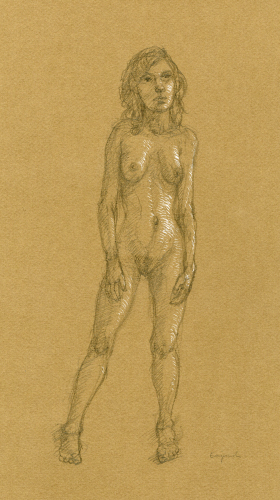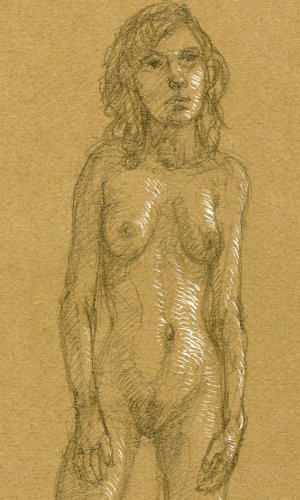Standing Figure
Post #1417 • November 12, 2009, 12:01 PM • 18 Comments

Standing Figure, November 6, 2009, pencil and white gouache on brown paper, 13 x 7 inches
The university where I teach has an Epson Expression 10000XL scanner with a 12 x 17 inch bed. I scanned some recent work on it, and now I'd like it to be known that donations are now being gratefully accepted towards the acquisition of this fine machine, which retails at roughly half the value of my car. Set to scan at 300ppi, a quarter of its maximum resolution, the image came in at 4000 pixels high. Actual size delivers greater detail than I could see while I was drawing the original.

detail
Here's a manageable detail.

detail
For reasons unclear to me, I am favoring realism again these days. Having just thrown away five months' worth of bad painting, I've taken that as an indicator, but the work in progress in the studio, a straightforwardly rendered nude drinking tea, is not ready to be shown yet. It told me so.
2.
November 12, 2009, 1:42 PM
Oh, and I think this one of the best figure drawings I've seen from you yet.
3.
November 12, 2009, 2:47 PM
Legs are short, head too large.
4.
November 12, 2009, 2:50 PM
charming drawing...if I may...you added the highlights...maybe try adding the extreme darks as well? It will give you a fourth value, I know, but the highlight is so strong that in this case you may need that darkness to balance it....or maybe just darken the darks and keep it a simple three value drawing. Anyhow it really is a quirky charming drawing..I'd want it.
5.
November 12, 2009, 4:10 PM
She has the proportions of a younger person, maybe not fully grown. It's kind of Balthusian that way. It doesn't make the drawing bad.
6.
November 12, 2009, 4:21 PM
Yes Chris, big head & short limbs are characteristic of the very young. Long arms, fully developed breasts, maybe not.
For "realism" (Franklin's goal), proportion often trumps small scale detail.
According to a friend who has talked with Epson tech support, the Expression 10000XL is a more accurate scanner than newer models that sport numerically higher resolutions.
7.
November 12, 2009, 4:24 PM
The model is 23 years old and 5'10". Make of it what you will.
Higher numbers aren't everything when it comes to cameras as well. I've been meaning to research the other important parameters but haven't gotten around to it.
8.
November 12, 2009, 4:40 PM
Maybe realism is not the right word. The thing in the studio is just a painting with a figure in it. And a cat.
9.
November 12, 2009, 4:56 PM
Obviously the age and size of the model don't say anything about your drawing. It could be she's shaped funny or it could be you were less than accurate or both. I mean, I suppose she could just have a big head.
Personally my comic book background leads me to make heads too small, since the "heroic" figure is eight heads tall, which is about a head taller than your standard-issue human. I eyeball your figure here as about six heads tall.
I still don't think it has any bearing on the quality of this drawing, which I think is high. Your anatomy is strong, the pose is good and evocative, your forms have weight and shape. It works.
Regarding scanners, there are a lot of crazy factors involved in quality, but most of them are beyond my ken. If you're not doing work intended for print, most of it is probably overkill.
I love that you can get closer in the scan than you can in real life. I took some scans of Conté drawings I did and used the tracing feature in Adobe Illustrator. It was able to trace around the grains of charcoal on the raised texture of the paper. The technology is so ridiculous now. I remember the hoops I had to jump through to get ink drawings scanned at 100 dpi using a hand scanner back in 1990. We're so damned rich now.
10.
November 12, 2009, 5:03 PM
You can get a tabloid flatbed scanner for less than $200. It's certainly not as awesome as the Epson, but for the price, you can't go too far wrong.
11.
November 12, 2009, 5:08 PM
I've seen that. Those Musteks get very mixed reviews.
12.
November 12, 2009, 5:15 PM
Chris, one of my favorite Turkish quotes: "I'm too poor to buy cheap stuff"
13.
November 12, 2009, 6:21 PM
RE: digital cameras and "numbers".
Yes indeed there is more to it than megapixels. The best cameras have larger CCDs, no matter how many pixels. The Canon Rebel is now, I think, up to 20 or so megapixels, but the CCD is still smaller than a piece of 35 mm film.This results in images with more noise in them than those taken with cameras with full sized CCDs (i.e., the same size as a piece of film) and an equal number of megapixels. And then there is the matter of glass, and sensitivity to light, and on and on. If you have the bucks, you can get a Hassleblad 6 cm x 6 cm. From what I hear, at that point additional "quality" does not give you a visible difference.
For my money, though, none of this quite measures up to silver based film as the starting point. But be sure and use a $20,000 Imacon quasi drum scanner to digitize the image on the film. It will then stand up to enlargement and printing at 2800 dpi better than silver based paper - though silver paper performs at essentially an infinite number of dots per inch.
Or you can use a Helga and be very hip.
14.
November 12, 2009, 9:09 PM
My main guideline when giving digital camera advice is to say you're better off getting one from a photography company than an electronics company. Because anyone can do electronics, but lenses and such require photography expertise. So generally that means Canon or Nikon. From what I've read the differences between the two are basically religious. They perform about the same.
The word "Hasselblad" pops up now and then when I read about photography but rarely in any serious way. Perhaps truly wealthy people have different conversations. Down here, where the little people can only spend two to three grand to start, we speak of Canon and Nikon.
Sony has a deal with an old German optics company. Name escapes me now. I don't trust it, though. Seems too easy for the German company to outsource its cheap Sony lenses to some crappy subcontractor. Zeiss. Zeiss lenses. That's the company.
I've been very, very happy with my Canon Rebel. And I have the original model. I don't do anything too serious with it, though. I'm basically an advanced amateur. A friend of mine who does some professional photography has the next model up, the 50D, I think.
15.
November 12, 2009, 9:14 PM
Musteks aren't known as the best scanners or anything, but they do tend to have Linux drivers, which to me is a good sign.
My current scanner, which has handled being moved around and taken apart a few times, is a Microtek. It's not tabloid, though, just regular.
16.
November 13, 2009, 1:33 AM
As an old photo major, and former Leica fiend, I'd always go with a Zeiss lens. I just use an old Olympus 3040- only 3.5 megapixels (less than some phones by now I'm sure), but I chose it for the lens which is fantastic - fast and sharp. One of these days I'll have to upgrade.
Nice drawing Franklin, and very Balthusian.
17.
November 13, 2009, 7:09 AM
Thank you.
And to whomever hit Artblog.net with seventy comment spams between bedtime last night and this morning, go drink bleach.
18.
November 13, 2009, 9:51 AM
Screw it - comments are closed for the rest of the day. I'm way too busy to be doing battle with this.
1.
Chris Rywalt
November 12, 2009, 1:41 PM
High-end scanners are frightening. Of course, a good digital camera (or even an older Canon Digital Rebel like mine) can achieve astonishing resolution also. Still, there's nothing quite like a professional scanner. Even the cheap consumer scanners are amazing as long as your work is small enough.
Photoshop CS3 and newer has a fantastic stitching function, too, so you can scan larger items in multiple passes and put the scans together into one image. I've had good results with that, too.